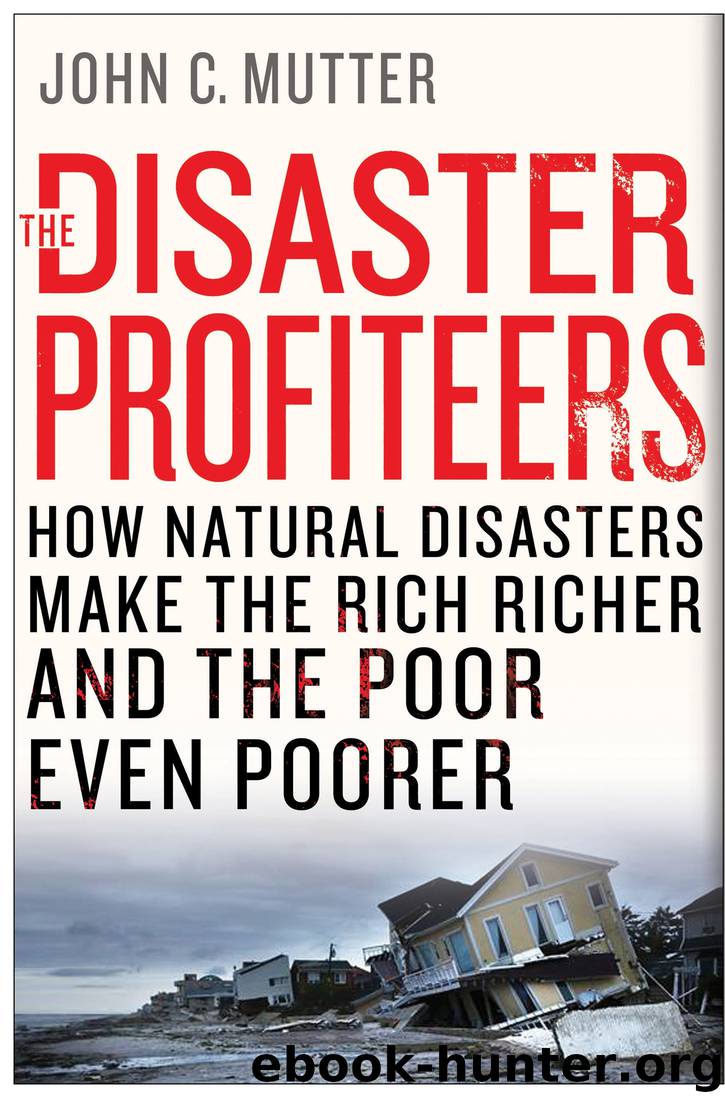The Disaster Profiteers: How Natural Disasters Make the Rich Richer and the Poor Even Poorer by John C. Mutter

Author:John C. Mutter [Mutter, John C.]
Language: eng
Format: epub
Tags: Non-Fiction, Sociology, Urban, Disasters & Disaster Relief, Science, Environmental Science, Architecture
ISBN: 9781466879416
Google: _GY5BgAAQBAJ
Amazon: 1137278986
Barnesnoble: 1137278986
Goodreads: 23014625
Publisher: Macmillan
Published: 2015-08-10T23:00:00+00:00
Chapter 6
Struck Dumb in New Orleans
The disasters in Myanmar and Haiti are similar to those in New York and New Orleans in that each was worse than it should have been. This chapter discusses why they were so bad and who made them that way.
Unlike in Myanmar or Haiti, in New Orleans there is a middle class with many vibrant businesses, especially around tourism and entertainment, and some of the people who run them are quite prosperous. Tulane University, Loyola University, and the University of New Orleans are major employers, as are hospitals, the port facility, and the petrochemical industry. But a great majority of those who live in New Orleans are stuck fast in a poverty trap: unemployed, undereducated, and unhealthy, with little hope of progress and mobility. The majority of those who live in New Orleans were born there. For some, evacuation from the city in the face of a hurricane means going somewhere very unfamiliar.
New Orleans is the largest city in the second-poorest state in the United States. (Mississippi, the state immediately adjacent to the east, ranks the poorest.)1 Household income inequality in New Orleans is also the second highest in the country, behind Atlanta, Georgia.2 The American Human Development Project calculated a Human Development Index (using a different formula from that used by the United Nations Development Program) that places Louisiana third from the bottom, with Mississippi again coming in last.3
Poverty is deeply racial in Louisiana. Twenty-five percent of white families have incomes over $100,000, and only 7 percent have incomes less than $15,000. For African Americans, those figures are exactly reversed—only 7 percent have incomes over $100,000, and 25 percent have incomes below $15,000.4
The geographic setting of New Orleans is not unlike that of Yangon in Myanmar. Both lie in the sweeping bend of a river—the Mississippi and Yangon Rivers respectively—that flows in complex meanders into fertile deltas immediately to their south. Both are major centers for shipping, and both export products from their country’s interior.
Poverty reflects geography in New Orleans. It is quite literally invisible to the tourists on Bourbon Street who are so important to the city’s economy, because it is confined to distinct regions where there are no tourist attractions, notably the Lower Ninth Ward and Gentilly. According to Alan Berube and Bruce Katz of the Brookings Institution:
These neighborhoods did not appear by accident. They emerged in part due to decades of policies that confined poor households, especially poor black ones, to these economically isolated areas. And despite New Orleans’ reputation for fine food, these areas are food deserts as well, relying on small bodegas with limited selections. The federal government concentrated public housing in segregated inner-city neighborhoods, subsidized metropolitan sprawl, and failed to create affordable housing for low-income families and minorities in rapidly developing suburbs, cutting them off from decent housing, educational, and economic opportunities.5
The Lower Ninth Ward of New Orleans looks nothing like the Cité Soleil slum of Port-au-Prince, but functionally the two are essentially the same. They
Download
This site does not store any files on its server. We only index and link to content provided by other sites. Please contact the content providers to delete copyright contents if any and email us, we'll remove relevant links or contents immediately.
Man-made Catastrophes and Risk Information Concealment by Dmitry Chernov & Didier Sornette(5909)
The Revenge of Geography: What the Map Tells Us About Coming Conflicts and the Battle Against Fate by Kaplan Robert D(4029)
Zero Waste Home by Bea Johnson(3765)
COSMOS by Carl Sagan(3542)
Good by S. Walden(3473)
In a Sunburned Country by Bill Bryson(3470)
The Fate of Rome: Climate, Disease, and the End of an Empire (The Princeton History of the Ancient World) by Kyle Harper(2991)
A Wilder Time by William E. Glassley(2806)
Camino Island by John Grisham(2751)
The Ogre by Doug Scott(2624)
Organic Mushroom Farming and Mycoremediation by Tradd Cotter(2618)
Human Dynamics Research in Smart and Connected Communities by Shih-Lung Shaw & Daniel Sui(2461)
Energy Myths and Realities by Vaclav Smil(2427)
The Traveler's Gift by Andy Andrews(2401)
9781803241661-PYTHON FOR ARCGIS PRO by Unknown(2314)
Inside the Middle East by Avi Melamed(2296)
Birds of New Guinea by Pratt Thane K.; Beehler Bruce M.; Anderton John C(2215)
A History of Warfare by John Keegan(2174)
Ultimate Navigation Manual by Lyle Brotherton(2119)
